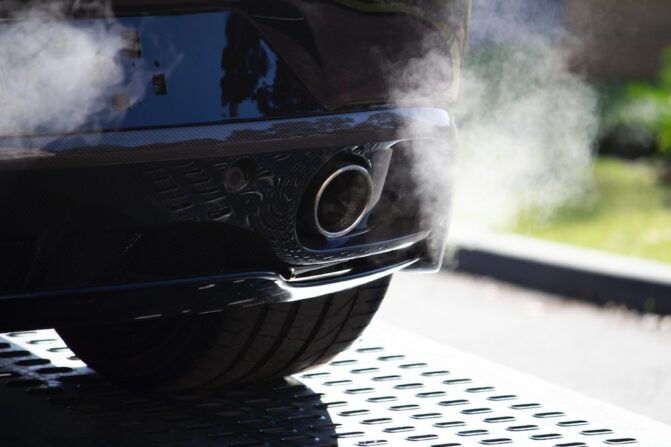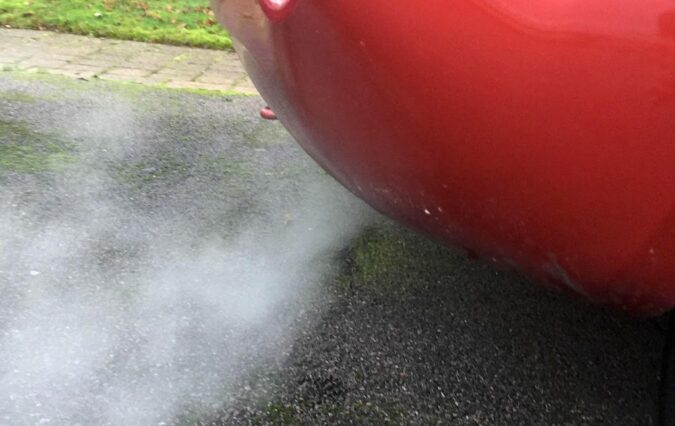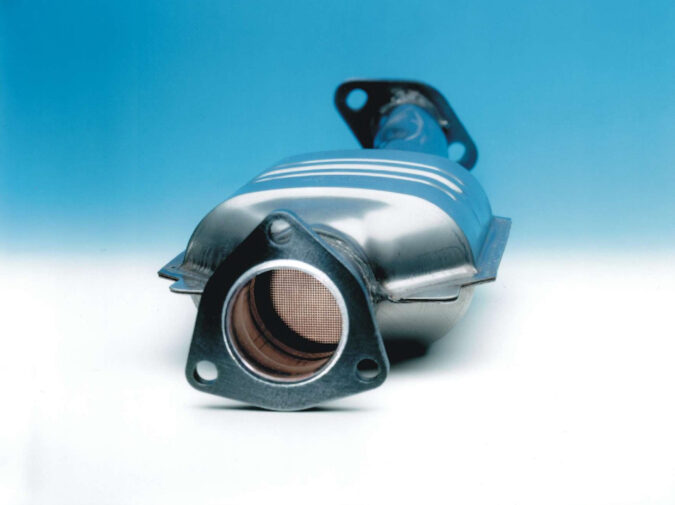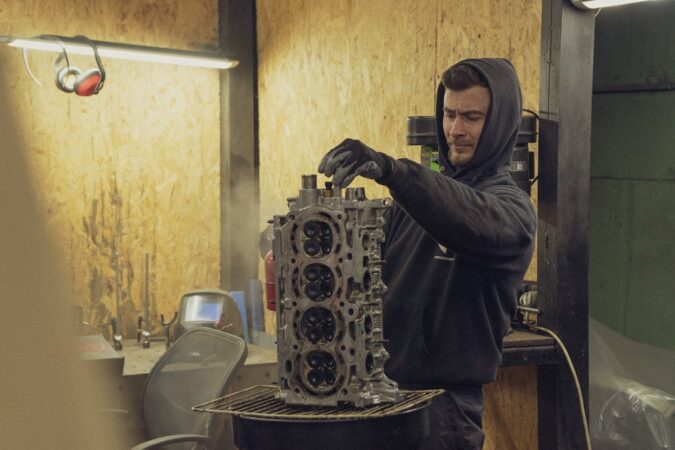The basics of how a car works, when condensed sufficiently enough, are quite easy to understand. Air and fuel are compressed, ignited, and combusted inside the engine. Hence, creating power to turn a series of mechanical bits and bobs, helping to move your car along. Meanwhile, gases are exhausted out from the engine, and through your tailpipes. But what about water coming out of exhaust?
Surely, that’s not normal, right? As you can imagine, water isn’t at all an equation in regards to your car’s combustion process. So, why is it that you’re clearly seeing H20 exhausting from your tailpipes as if you’ve been burning water? Well, this isn’t an uncommon scenario, and it’s fairly normal for you to see water coming out of exhaust. For the most part, it can be attributed to simple condensation.
Your engine is a hot little thing, after all. In this case, you won’t have to worry about anything at all. However, there are situations where H20 dripping or shooting out of your tailpipe can be a cause for concern. It might point towards there being serious faults inside of the engine, which if not rectified right away, could cause catastrophic failure. So, here’s why there’s water coming out of exhaust.
The first step in all this is not to panic, and logically diagnose why you’re seeing water coming out of exhaust. Methodical reasoning has never failed to help folks precisely pinpoint issues with their cars, and figure out what to do next. The first step that you should undertake when seeing water coming out of exhaust, is to turn off the engine. This is just in case the cause might be something serious.
What Should You Do Now, Seeing Water Coming Out Of Exhaust?
Once you’ve done that, follow these steps to determine if you actually have a problem on your hands with water coming out of exhaust. Or, if it’s simply condensation…
- Obverse if there’s smoke emanating from the exhaust alongside the droplets of water.
- Yes – Note down the color and thickness of the smoke. Is it white, black, or blue-colored smoke? Also, does it appear in thick plumes, or as a fine fog? This could lead to something quite bad.
- No – If it’s a thin mist on a cold day, it’s probably just condensation. The same way where you could visibly see your breath as you exhale on a winter’s morning.
- Now, you can inspect if there’s a scent and, if you’re willing, taste the fluids (obviously, dip it onto the tip of your tongue, and spit it out thoroughly afterward) leaking out from the exhaust.
- Yes – Does it smell (and taste) somewhat sweet? If so, that might be coolant (or antifreeze, as some might call it) that’s coming from the exhaust, not water.
- No – Are you only smelling the fumes from the exhaust? And, does this fluid not have a distinctive smell or taste, merely neutral? In that case, it’s likely just water.
- Once that’s done, smear some of that fluid onto your hands, and record what this liquid feels like in the hand. Does it feel slick or greasy?
- Yes – If there’s a greasiness to the feel, it might be motor oil or unburnt fuel (gasoline, or diesel). You could also see if there’s a shiny puddle or drips somewhere near the exhaust.
- No – Does this fluid run off your hands, and leave it wet? If that’s the case, then you’re dealing with water, once again.
What’s Causing You To See Water Coming Out Of Exhaust?
Having established the type of liquid that’s leaking out of the exhaust, you can begin to put together what’s caused it to occur in the first place. We must stress, that on most occasions, seeing traces of water coming out of exhaust is fairly normal. That’s especially so if you live somewhere cold, or if it’s snowy or chillier than usual. In other words, there’s no cause to panic or worry just yet.
For the most part, water dripping out of your tailpipes is a sign of condensation. Many people see it as a good sign, as it tells them that the engine has cooled down properly. And, your exhaust is working just fine. In other instances, water is a sign that your engine’s been running a bit warm. It should be expected, especially after a day of long-distance cruising or hard driving on the track.
Alternatively, you could see water exhausting from your tailpipes as an indication that your catalytic converters are in good shape. Again, not only normal but can be interpreted as a good thing. But, there are also quite a lot of cases where seeing water coming out of exhaust isn’t ordinary. Nor, is it a good sign of anything, other than a symptom of serious troubles brewing within your car.
So, here’s a round-up of the most common causes of why you’re seeing water coming out of exhaust, and how to spot them…
1. Condensation From The Engine
First, let’s elaborate on the most frequently seen type of water coming out of exhaust; condensation from the engine. As we’ve highlighted earlier, this isn’t out of the ordinary. When an engine is going through its typical combustion process, the ignition of fuel and air creates pollutants.
These pollutants are then exhausted as fumes out of the engine before more fuel and air is burnt to create more pollutants. And, the cycle repeats, so long as your engine is running. So, what are these pollutants (or, by-products)? The big-3 include carbon dioxide, nitrogen, and water vapor.
What this means, is that water is almost always coming out of your exhaust pipes. Although, and for most of the time, water is heavily mixed in with carbon dioxide and nitrogen. Thus, water exhausts in fine mists that can barely be felt or seen with the naked eye. So, what about large amounts of it?
When the engine is in the process of cooling down, or if you’ve just turned it off, water vapor could collect as condensation within the exhaust pipes. Sometimes, you might also see it dripping off the tip of the tailpipes. This isn’t peculiar, as the drips will stop and disappear a few minutes in.
However, there might still be a bit of water left deep inside the exhaust. This is why in some cases, as you’re turning the engine on, a burst of water is shot through the tailpipes. As your engine cranks to life, this is quite normal. The new combustion cycle is merely evacuating condensation out.
2. Your Engine Is Warming Up Or Running Hot
Engines get pretty hot. The normal operating temperature of an internal combustion engine is in the neighborhood of 195°F to 220°F. It can peak to around 250°F at the most. Now, much of this heat is created during the initial start-up and ignition of an engine.
Quite simply, and at this early stage when your car’s engine is barely just running, its cooling hasn’t yet reached an optimal status. In other words, while your engine has started, oil and coolant need a bit more time to circulate and cool the engine (as well as its many moving parts) down.
While coolant and oil are slowly flowing around, the engine will continue to gather heat, before then tapering off into a more comfortable operating temperature. Meanwhile, and as the engine’s heat is spreading throughout the rest of the car, your exhaust system will get pretty toasty, too.
Once again, this will create some condensation in the exhaust system, especially if the temperature outside is rather frosty. As your engine begins exhausting fumes, it’ll force the water vapor inside the exhaust to clear out. As with our previous point, this isn’t indicative of a problem.
NOTE: Most of the time, this is fairly routine. Give it a couple of minutes, and you should stop seeing water coming out of exhaust. Nevertheless, and if water keeps on dripping out of the tailpipes after those few minutes, it might be a sign that something’s amiss (we’ll discuss them below).
3. By-Products Of Your Catalytic Converter
Practically every car in the last few decades has catalytic converters. The combustion process that occurs within an engine is incredibly toxic. Exhaust fumes created as a result have led to pollution and a rapid rise in carbon emissions, not to mention heightening health hazards for everyone.
Thankfully, our air is quite a bit cleaner now thanks to the advent of catalytic converters. Through a process of catalysis, a catalytic converter traps the fumes leaving your engine. They can then scrub it clean by converting or breaking down the most toxic pollutants into relatively harmless ones.
The latter includes carbon dioxide (not ideal, but still far less deadly than others), as well as water, or H20. Yes, fine traces of water are created through the chemical catalysis process. Though, you’ll still be able to spot these droplets trickling out of the exhaust. Once more, this is to be expected.
4. Blown Or Failed Head Gasket
The (short) list of harmless, innocent, and ordinary causes for why you’re seeing water coming out of exhaust ends there, unfortunately. From this point on, we’ve got nothing short of bad news after one another, as the signs of water trickling out from your exhaust pipes could signify serious faults.
The first of many would be blown head gaskets. A head gasket is a slim gasket that essentially forms a seal between the engine block and the cylinder heads. In practice, this helps to seal combustion gases inside of the engine, as well as to prevent outside elements from leaking in.
In particular, you wouldn’t want coolant (antifreeze), engine oil, or other contaminants to seep into the combustion chamber, which would otherwise burn with the fuel. Unfortunately, a head gasket isn’t made to last forever, and over time, it can form leaks or is “blown”, as they say.
When this happens, the seals wear down, and it allows for gases to escape the combustion chamber. Meanwhile, oil, coolant, and so forth could easily leak into the engine, causing further issues. One of the symptoms of a blown head gasket happens to be water coming out of exhaust, as well as:
- Plumes of white smoke emitted from the tailpipes.
- Constant overheating issues, or your engine running hotter than usual.
- Air bubbles, and bubbling in the coolant (antifreeze) reservoir.
- Low levels of oil and coolant, as it’s been silently leaking into the engine.
- Oil or coolant dripping out of the tailpipes.
NOTE: A blown head gasket is a major problem in any vehicle. Therefore, you should promptly have it checked out by a mechanic, and get the head gasket replaced. Delay for much longer, and you’ll continue to experience overheating. The latter could cause permanent damage to the engine.
5. Compromised Pistons Or Bad Piston Rings
Well, here’s another concerning, expensive, and complicated fix to seeing water coming out of your exhaust pipes. In a car, the pistons sit inside the cylinder, as a part of the combustion chamber. As air and fuel are ignited, the force from this small explosion pushes the piston down.
As it’s forced downwards, the pistons rotate the crankshaft. Repeated up and down motion of all the pistons in your engine will continue to drive the crankshaft, as power is sent to the transmission, and eventually, your wheels. That is how your engine transmits power through combustion.
Between the pistons and the cylinder walls, there are a series of piston rings. These rings function to avoid the cylinder walls and pistons from contacting each other physically, which can be damaging. Additionally, it helps to keep fuel in the combustion chamber sealed.
And, prevent motor oil (which flows freely in the crankcase of the engine for lubrication, underneath the pistons) from entering the combustion chamber. While they have a vital role to play, piston rings are susceptible to wear out due to old age. Plus, the pistons themselves could be faulty.
In any case, either a damaged piston or a worn-out piston ring can prompt you to see water coming out of exhaust. Albeit, this is rarely the case, unless the head gaskets happen to fail alongside it, as well. Besides water droplets from the tailpipes, they may exhibit other symptoms, such as:
- Plenty of blow-by in the engine, which will adversely affect performance.
- Significant amounts of dark and sooty smoke, sometimes blue in color.
- Oily marks and residue around the tailpipes.
- A burning smell, which can be felt inside the cabin.
NOTE: Just like a blown head gasket, bad pistons or worn piston rings should be addressed promptly.
6. Faulty EGR (Exhaust Gas Recirculation) Cooler
Just like catalytic converters, an EGR is a commonplace inclusion in many modern cars. They’re a bid to help eliminate the finer, yet deadly, pollutants from your car’s emissions, such as nitrogen oxide. They can be featured on both gasoline and most prominently, diesel-powered vehicles.
As its name (exhaust gas recirculation) might suggest, an EGR functions to recirculate some of the exhaust fumes back into the engine. In doing so, these fumes can act as absorbents, soaking in some of the engine’s combustion heat. With less heat in the engine, it can perform more efficiently.
In addition, lower combustion heat results in smoother, more reliable, and optimized performance from the engine. Amongst the many components that make up the EGR system, there’s a cooler, as well. This EGR cooler works to cool off the exhaust gases before returning to the engine’s intake.
The bad news here is that an EGR cooler can, under some circumstances, fail. More specifically, we have to look at the sections where the coolant is used to cool down the exhaust gases. This particular section of the EGR cooler is vulnerable to cracking.
When it finally gives way, coolant can enter the exhaust system, before later being found dripping out of the tailpipes. If you happen to pick up a sweet scent from those fluids leaking out of the exhaust, there’s a strong chance that you’re smelling coolant, not water.
NOTE: You can technically still drive around for a little while, even with a cracked and leaking EGR cooler. Nonetheless, you’ll immediately begin to notice your vehicle running more roughly, shake or vibrate far more vigorously, as well as hear popping sounds from the exhaust.
7. Water Left Behind From Flooding
This isn’t as bad as the others, thankfully. There’s a possibility that the water you’re seeing exiting the tailpipes might not even come from your vehicle. Maybe, it’s water from the outside, simply having made its way into the exhaust system.
It won’t apply to most of you, but it could still happen. This is commonly seen during flooding, where your car is wading through water that is clearly above the tailpipes. Or, perhaps if you’re fording a river or stream in your car, and may not have noticed how deep it was.
Water can ingress into the exhaust system. This isn’t good, as it can cause the engine to stall. But once you’re on higher ground, it shouldn’t take long (just a couple of minutes) for water to drain out and be forced out of the tailpipes.
How Can You Solve Seeing Water Coming Out Of Exhaust?
Having now become acquainted with what’s caused you to notice water coming out of exhaust, how can you solve it? Well, if it’s a matter of condensation from your engine, exhaust, or is a by-product of the catalytic converters, then you won’t have to do anything. However, let’s say your symptoms or diagnosis lines up with a blown head gasket, bad pistons, or faulty EGR, action needs to be taken.
And swiftly, as these issues, if not solved right away, can lead to serious problems with the engine down the line. Here’s a quick guide on how to solve them:
- Blown Head Gasket – Only a replacement will suffice for a permanent fix, as you’ll have to swap out the entire head gasket. This can cost you at least $1,000 in most cases. Although, the cost is known to skyrocket to $2,000 or more. That’s not considering any other damage to the engine besides.
- Piston Rings – These have to be replaced in full. You can look at a price tag of $1,500 to $2,500 for a full replacement job. But depending on how many cylinders (and thus, pistons) you have in your car, or the complexity of the engine, this expense could rise further to $5,000 or more.
- EGR Cooler – Alas, these can’t be fixed easily, and a complete replacement will have to be done. On average, you might be paying as little as $500. However, it mostly averages at around $1,000, with a top-end estimate of approximately $1,500 or higher.
Facts about Water Coming Out of Your Car’s Tailpipe
- The exhaust system is built in cars to allow exhaust gases to flow out of the engine and into the atmosphere through a tailpipe.
- Water coming out of the tailpipe doesn’t always mean there is a problem.
- The main pollutants formed during the combustion process in the engine are water vapor, nitrogen, and carbon dioxide.
- Water condensation in the exhaust becomes visible outside the tailpipe as the engine cools down.
- If the water drips from the tailpipe stop within a couple of minutes after the engine warms up, there is nothing to worry about.
- Water vapor in the exhaust can be produced if the temperature outside is cold, and the engine is hot.
- Every car has a catalytic converter that lowers the toxic gas emissions in the exhaust and produces water vapor in the conversion process.
- Blown head gaskets can cause water to come out of the tailpipe, manifesting as white smoke and overheating issues.
- Bad pistons or worn piston rings will not generally cause water out of the tailpipe but can create sooty exhaust, blue smoke, or oily residue around the tailpipe.
- Water condensation in the exhaust system is a common occurrence, particularly in cold weather conditions.
Final Thoughts On Water Coming Out Of Exhaust
As you can see, the problems that might be alerted by water coming out of the exhaust aren’t cheap to solve. More often than not, you’re paying thousands of dollars. Primarily, these will go towards labor charges, as these issues take a significant quantity of time and energy to resolve. In many instances, the repair costs are so astronomical, that it’s more cost-effective to simply scrap the car.
Replacing a blown head gasket, piston ring, piston, or EGR cooler isn’t an ideal scenario. At least, you may be able to rest assured the water coming out of exhaust is nothing but mere condensation. A bit of vapor every now and then can be considered a very healthy sign. For example, knowing that the catalytic converters are working fine, emitting some water, as they should be doing.
Elsewhere, do be wary whether what you’re seeing is actually water. Might it be coolant, motor oil, or in a few rare cases, unburnt fuel? Was there any smoke that accompanied this leakage from the exhaust pipes? Or, was there a distinct smell or taste to the fluids? If you notice any of these, then a trip to a nearby mechanic is recommended. Do so quickly, and you may prevent needing costly repairs.






